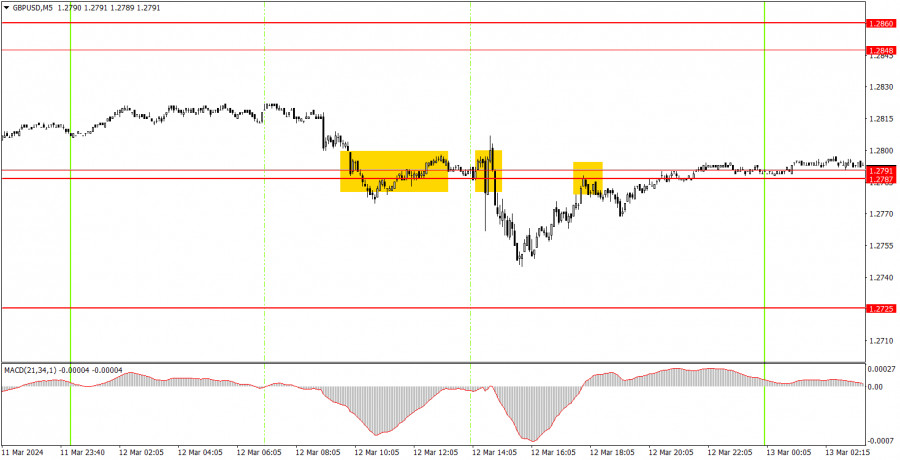

GBP/USD continued to trade lower on Tuesday amid strong US inflation data. It's worth noting that the slower inflation falls (or rises), the fewer reasons the Federal Reserve has to lower interest rates, even in June. On the other hand, expectations regarding the Bank of England's rate remain unchanged. For now, it's August, but the British central bank faces slightly different circumstances, as they need to keep the rate at its current level for as long as necessary. The British economy has already slipped into a recession. It may not be severe, but now the BoE is also forced to consider this issue, and not just high inflation. Either way, hawkish expectations for the Fed rate are increasing, which should support the dollar. As expected, the greenback grew on Tuesday, but unfortunately, it was more of an exception to the rule. Generally, over the past six months, the market has been trading in an unreasonable manner, as it completely ignores the fundamental and macroeconomic background.
GBP/USD on 5M chart
Several signals were generated on the 5-minute timeframe. Initially, the pair either overcame or bounced off the 1.2787-1.2791 range. We advise you to ignore such vague signals. Next, there was another bounce from the area of 1.2787-1.2791. In fact, the US inflation report was published at this time. Beginners could open short positions about 15 minutes after the report was released, but the pair only fell by 28 pips and obviously it did not reach the nearest target level. The third signal around the area of 1.2787-1.2791 should have been ignored since the first two turned out to be a false signal.
Trading tips on Wednesday:On the hourly chart, GBP/USD intends to resume the upward trend, although there are no fundamental and macroeconomic grounds for it. The pair has consolidated below the ascending channel, but this does not guarantee that the pound will continue to fall. The market is focused on buying, and it doesn't need any corresponding data to buy the pound.
The key levels on the 5M chart are 1.2372-1.2387, 1.2457, 1.2502, 1.2544, 1.2605-1.2611, 1.2648, 1.2691, 1.2725, 1.2787-1.2791, 1.2848-1.2860, 1.2913, 1.2981-1.2993. On Wednesday, the UK will release reports on GDP and industrial production for January. Both reports are not crucial, and we do not expect a strong reaction to them. Meanwhile, the US economic calendar is relatively quiet. It will probabl be another boring day.
Basic trading rules:1) Signal strength is determined by the time taken for its formation (either a bounce or level breach). A shorter formation time indicates a stronger signal.
2) If two or more trades around a certain level are initiated based on false signals, subsequent signals from that level should be disregarded.
3) In a flat market, any currency pair can produce multiple false signals or none at all. In any case, the flat trend is not the best condition for trading.
4) Trading activities are confined between the onset of the European session and mid-way through the U.S. session, after which all open trades should be manually closed.
5) On the 30-minute timeframe, trades based on MACD signals are only advisable amidst substantial volatility and an established trend, confirmed either by a trendline or trend channel.
6) If two levels lie closely together (ranging from 5 to 15 pips apart), they should be considered as a support or resistance zone.
How to read charts:Support and Resistance price levels can serve as targets when buying or selling. You can place Take Profit levels near them.
Red lines represent channels or trend lines, depicting the current market trend and indicating the preferable trading direction.
The MACD(14,22,3) indicator, encompassing both the histogram and signal line, acts as an auxiliary tool and can also be used as a signal source.
Significant speeches and reports (always noted in the news calendar) can profoundly influence the price dynamics. Hence, trading during their release calls for heightened caution. It may be reasonable to exit the market to prevent abrupt price reversals against the prevailing trend.
Beginners should always remember that not every trade will yield profit. Establishing a clear strategy coupled with sound money management is the cornerstone of sustained trading success.